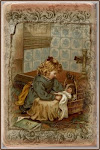 HOW TO MAKE PAPER LOOK OLD
HOW TO MAKE PAPER LOOK OLDCreating paper that looks old is not as hard as you may have thought. All it takes is some common household items and a little time and practice. If you need an authentic-looking treasure map or an old parchment to write a poem on, you don’t need a time machine – just an oven and some basic household supplies.
Tea Bag Staining
Drag a wet (not dripping) tea bag over your paper. Weight your paper down while it dries to avoid warping. The paper will be stained a brownish color. Keep your cup of tea handy, in case the teabag dries out, so that you can dip it again. Keeping the tea bag in the tea will produce a stronger yellow color. A lingering tea-smell might remain. Tea-bag staining is not acid free, if this matters to you.
Coffee Grounds Staining
Like tea, you can use coffee grounds to make paper look old. Apply wet coffee grounds to your paper. Remove grounds. The paper will be stained brown. Dry paper under a weight to avoid warping. As above, there is likely to be a coffee odor afterwards. Coffee grounds are also not acid free.
Soaking with Coffee
Make a really strong cup of black coffee. Use about eight times as much instant coffee powder as you would to drink.
Get a container (plastic will melt) that is a little bigger than the piece of paper you are using, like a 9x13" baking pan. It can be shallow. Make sure that that the paper is not so thin,so you don't need a very deep bath but just enough.
Pour about 1/4 inch of coffee into the bottom of the container.
Put your piece of paper into the liquid. Let it float on top, so that the coffee seeps through the back.
Using a spoon, spoon the coffee over the paper until it has a thin covering. Leave it for about a minute so that it absorbs the tannins.
Carefully, so as not to rip the damp paper, transfer it to another tray that has no coffee in it. You may want to hold it up for a second to let any excess coffee drain away.
Using your finger-nail or a spoon, tear little holes in the paper. Wad up the paper you removed and drop it in little lumps across the surface of the paper. When baked, these will merge back into the surface, creating lumps. These lumps make it look and feel more like parchment, the writing material used in the medieval ages.
Make sure there are no pools of liquid on the paper. Bake in an oven for 5-7 minutes at 200 degrees Fahrenheit until the paper has dried.
Take it out and let it cool. You now have a sheet of paper straight from the 1400s!
Balsamic Vinegar Spattering
Same as above. Expect odor. Vinegar is not acid free.
Lemon Juice
Paint your paper with lemon juice, then heat with a heat gun. The paper will take on a brownish, aged look. It will continue to darken as you continue to apply heat. Lemon juice is not acid free.
Decorating Chalks
These chalks are my favorite way to make paper look old. Apply the chalk (one of the brownish colors) to the paper using a cotton ball, makeup sponge, Q-tip or swab. This is especially effective on the ripped edges of paper or vellum. Allow the chalks to set, or spray with a fixative if speed in important. Decorating chalks have many uses when making altered books. Acid free decorating chalks are available at joann.com.
Walnut Ink
Walnut ink is made from black walnuts. It is usually sold in crystallized form, and must be hydrated before using. Apply the wet walnut ink to the paper, lace, fabric or other material. You can create various effects as you strive to make paper look old. For more information about walnut ink, refer to the Definitions page of this web site.
Paper Tearing
Instead of cutting your paper neatly, tear it. Holding the paper towards you while you tear will produce one look; holding it away from you will produce another. Color the torn edges with decorative chalk, walnut ink, tea bags, or similar to give an aged appearance.
Sanding with Sand Paper
Lightly sand shiny paper or other paper to produce "tooth" or a worn look. Sand the same way you sand wood -- in a directional move, rather than circular.
 Paper Crumpling
Paper CrumplingCrumple up your paper. Flatten it out, crumple again. Repeat as often as you wish before using the paper in your layout. Iron the finished paper if desired, for a special look, or try placing the (thickest) paper in water before crumpling for yet a different look.
Paper Burning
Another way to make paper look old is to burn the edges of the paper. For safety's sake, do this over a sink, using a candle or stick of incense. Pinch the fiery edges out with your finger. If desired, wet an inner border on your paper before applying the flame. You can do the wetting with a damp Q-tip, paint brush, or your finger. This prevents the paper from burning more than you want, since the wet inner border will prevent the flame from going further.
Candle Waxing
Write over your paper with a white candle, covering as much area as you can. Crush the paper so the wax cracks. Apply paint over the surface, forming random cracks. Remove the wax by ironing your paper. Place it between two sheets of paper towels padded with newspaper on both sides and use a hot iron.
Matte Gel or Matte Medium
These products will take the shine off paper or pictures, etc.
 Tips
TipsExperiment with different quantities of tea in water. More tea leaves will make its color darker. Adding milk makes a different shade.
Add turmeric to the tea to get some grainy texture on the paper.
If you want to fold the parts of the paper do it, and then dip it, the folded parts will be darker. Don't use straight folds.
This is also a good method to use if your goal is to make Egyptian papyrus
Crush a paper with your hands and then straighten it again. Then applying tea solution will give interesting results.
If you use coffee to make the paper look old, add a few glasses of red wine to the coffee. Because the substance is different, the coffee will be on the "large" spaces while the wine will be in the "little wrinkles". This gives a very old effect.
Spray with transparent lacquer upon complete drying for extra finish.
You can use a piece of soft cloth instead of brush to apply the tea to the paper.
If you want a faster drying process, iron the paper on a low setting. Be careful not to do it immediately.
While in the pan, if you press down on the paper with a fork or another object, it will leave a cool imprint.
Plan what to write on your aged paper on a separate sheet of paper first. Write on the aged paper in pencil first, as to avoid permanent mistakes in pen. Begin writing in pencil lightly, then outline your writing in pen. Black ink is best.
Try a fountain pen or even a dip pen for authentic-looking writing. Look at old-style handwriting, too, and try to emulate it.
Not sure what you're going to get? Try whatever technique you think you will use on a sample before doing the real thing. Use the same materials as you'll use in your final project.
If you want, also you may soak the paper in vinegar, then put in oven at 200F for 5-10 min.
If using the coffee method, leave in oven (at 200F) for around 8 minutes.
If you want to make a piece of writing look old then simply type what you want up the trace it onto plain paper. Remember to do this before you crease or wet the paper.
If your paper smells too much like coffee and not the authentic “old paper” scent you want, stick the sheets in a box with some mothballs for a day or two.
Experiment with different colors to achieve the look you want; coffee will turn the paper a darker brown, tea will be lighter.
You can also wear holes in the middle of the sheet by rubbing it with your finger.
You can let the paper air dry, but weight the edges or the paper will curl
 WARNINGS:
WARNINGS:Don't put your paper too close to your candle flame or it will be set on fire.
Avoid using watercolor painting strokes (with less amount of liquid on brush) or else the brush strokes will be visible on paper and it won't give a smooth impression.
Don't set the paper on fire unless you dip the paper in water.
If using the Soaking Method, do not attempt to soak several pieces of paper at one time! The pages will stick together. Instead, soak your pages individually, using the same tea.
Don't let the paper soak for too long, or it will begin to degrade.
Practice the flame method on a different sheet of paper before you try it with your good sheet.
Putting the paper in the microwave may permanently damage your microwave and it will never work again and that would not be good!
To give writing the look of age, write using lemon juice. When the juice dries, hold the paper over a toaster and it will show up as a faded brown instead of fresh black.
The longer you soak a piece of paper in coffee or tea, the darker it will be.
Be careful when using any of these methods. They can be dangerous if not done properly.









.jpg)






































































.jpg)

























.JPG)











4 comments:
Thanks so much for all this info in one post. Big help in this busy days just before fall shows.
Sue, YOU create the best post! I love your blog and how you inspire so many people to do awesome things!
Love you and have the best of days!
Yvette
This is an AMAZING article would love to use in the xmas issue of Down the Primitive Path Ezine with a link back to your blog.. Please let me know if I have your parmission to use it..
dianebowling1964@sbcglobal.net
Hello, very useful post, I just used to think of downloading these textures and then i find you can make them! I am gonna do this. thank you so much!
Post a Comment